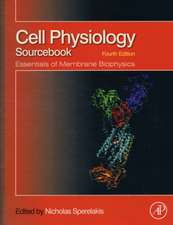Organelle Contact Sites: From Molecular Mechanism to Disease: Advances in Experimental Medicine and Biology, cartea 997
Editat de Mitsuo Tagaya, Thomas Simmenen Limba Engleză Hardback – 5 sep 2017
MCS, the intracellular structures where organellar membranes come in close contact with one another, mediate the exchange of proteins, lipids, and ions. Via these functions, MCS are critical for the survival and the growth of the cell. Owing to that central role in the functioning of cells, MCS dysfunctions lead to important defects of human physiology, influence viral and bacterial infection, and cause disease such as inflammation, type II diabetes, neurodegenerative disorders, and cancer. To approach such a multifaceted topic, this volume assembles a series of chapters dealing with the full array of research about MCS and their respective roles for diseases. Most chapters also introduce the history and the state of the art ofMCS research, which will initiate discussion points for the respective types of MCS for years to come.
This work will appeal to all cell biologists as well as researchers on diseases that are impacted by MCS dysfunction. Additionally, it will stimulate graduate students and postdocs who will energize, drive, and develop the research field in the near future.
| Toate formatele și edițiile | Preț | Express |
|---|---|---|
| Paperback (1) | 635.75 lei 38-44 zile | |
| Springer Nature Singapore – 12 dec 2018 | 635.75 lei 38-44 zile | |
| Hardback (1) | 1119.08 lei 3-5 săpt. | |
| Springer Nature Singapore – 5 sep 2017 | 1119.08 lei 3-5 săpt. |
Din seria Advances in Experimental Medicine and Biology
- 9%
 Preț: 719.60 lei
Preț: 719.60 lei - 20%
 Preț: 691.93 lei
Preț: 691.93 lei - 5%
 Preț: 717.00 lei
Preț: 717.00 lei - 5%
 Preț: 716.28 lei
Preț: 716.28 lei - 5%
 Preț: 717.20 lei
Preț: 717.20 lei - 15%
 Preț: 640.24 lei
Preț: 640.24 lei - 5%
 Preț: 1113.83 lei
Preț: 1113.83 lei - 5%
 Preț: 715.71 lei
Preț: 715.71 lei - 5%
 Preț: 820.43 lei
Preț: 820.43 lei - 15%
 Preț: 641.38 lei
Preț: 641.38 lei - 5%
 Preț: 716.28 lei
Preț: 716.28 lei - 5%
 Preț: 523.99 lei
Preț: 523.99 lei - 5%
 Preț: 1031.00 lei
Preț: 1031.00 lei - 5%
 Preț: 717.00 lei
Preț: 717.00 lei - 5%
 Preț: 715.35 lei
Preț: 715.35 lei - 20%
 Preț: 1161.71 lei
Preț: 1161.71 lei - 5%
 Preț: 1170.51 lei
Preț: 1170.51 lei - 18%
 Preț: 1119.87 lei
Preț: 1119.87 lei - 5%
 Preț: 1288.48 lei
Preț: 1288.48 lei - 5%
 Preț: 1164.67 lei
Preț: 1164.67 lei - 5%
 Preț: 1101.73 lei
Preț: 1101.73 lei - 18%
 Preț: 1123.67 lei
Preț: 1123.67 lei - 5%
 Preț: 1435.64 lei
Preț: 1435.64 lei - 20%
 Preț: 1044.10 lei
Preț: 1044.10 lei - 18%
 Preț: 946.39 lei
Preț: 946.39 lei - 5%
 Preț: 292.57 lei
Preț: 292.57 lei - 18%
 Preț: 957.62 lei
Preț: 957.62 lei - 18%
 Preț: 1235.76 lei
Preț: 1235.76 lei - 5%
 Preț: 1231.55 lei
Preț: 1231.55 lei - 5%
 Preț: 1292.30 lei
Preț: 1292.30 lei - 5%
 Preț: 1102.10 lei
Preț: 1102.10 lei - 18%
 Preț: 1132.81 lei
Preț: 1132.81 lei - 5%
 Preț: 1165.19 lei
Preț: 1165.19 lei - 5%
 Preț: 1418.48 lei
Preț: 1418.48 lei - 5%
 Preț: 1305.63 lei
Preț: 1305.63 lei - 18%
 Preț: 1417.72 lei
Preț: 1417.72 lei - 18%
 Preț: 1412.99 lei
Preț: 1412.99 lei - 24%
 Preț: 806.16 lei
Preț: 806.16 lei - 18%
 Preț: 1243.29 lei
Preț: 1243.29 lei - 5%
 Preț: 1429.44 lei
Preț: 1429.44 lei - 5%
 Preț: 1618.70 lei
Preț: 1618.70 lei - 5%
 Preț: 1305.12 lei
Preț: 1305.12 lei - 18%
 Preț: 1124.92 lei
Preț: 1124.92 lei - 5%
 Preț: 1097.54 lei
Preț: 1097.54 lei - 15%
 Preț: 649.87 lei
Preț: 649.87 lei - 5%
 Preț: 1097.54 lei
Preț: 1097.54 lei - 18%
 Preț: 945.79 lei
Preț: 945.79 lei - 5%
 Preț: 1123.16 lei
Preț: 1123.16 lei
Preț: 1119.08 lei
Preț vechi: 1364.73 lei
-18% Nou
Puncte Express: 1679
Preț estimativ în valută:
214.13€ • 233.33$ • 180.44£
214.13€ • 233.33$ • 180.44£
Carte disponibilă
Livrare economică 02-16 aprilie
Preluare comenzi: 021 569.72.76
Specificații
ISBN-13: 9789811045660
ISBN-10: 9811045666
Pagini: 290
Ilustrații: VIII, 257 p. 43 illus., 42 illus. in color.
Dimensiuni: 178 x 254 mm
Greutate: 0.74 kg
Ediția:1st ed. 2017
Editura: Springer Nature Singapore
Colecția Springer
Seria Advances in Experimental Medicine and Biology
Locul publicării:Singapore, Singapore
ISBN-10: 9811045666
Pagini: 290
Ilustrații: VIII, 257 p. 43 illus., 42 illus. in color.
Dimensiuni: 178 x 254 mm
Greutate: 0.74 kg
Ediția:1st ed. 2017
Editura: Springer Nature Singapore
Colecția Springer
Seria Advances in Experimental Medicine and Biology
Locul publicării:Singapore, Singapore
Cuprins
Part 1: Overview of Organelle Contacts.- Chapter 1: Organelle Communication at Membrane Contact Sites (MCS): From Curiosity to Center Stage in Cell Biology and Biomedical Research.- Part 2: Organization and Roles of Organelle Contact Sites.- Chapter 2: Over Six Decades of Discovery and Characterization of the Architecture at Mitochondria-Associated Membranes (MAMs).- Chapter 3: Regulation of mitochondrial dynamics and autophagy by the mitochondria-associated membrane.- Chapter 4: Endoplasmic Reticulum-Mitochondria Communication Through Ca2+ signaling: the importance of mitochondria associated membranes (MAMs).- Chapter 5: Ceramide transport from the endoplasmic reticulum to the trans Golgi region at organelle membrane contact sites.- Chapter 6: Endoplasmic Reticulum - Plasma Membrane cross-talk mediated by the extended synaptotagmins.- Chapter 7: Endoplasmic Reticulum–Plasma membrane contacts regulate cellular excitability.- Chapter 8: The lipid droplet and the endoplasmic reticulum.- Chapter 9: Role of intra- and inter-mitochondrial membrane contact sites in yeast phospholipid biogenesis.- Chapter 10: Discovery and roles of ER-endolysosomal contact sites in disease.- Part 3: Infection and Disease.- Chapter 11: Alzheimer disease.- Chapter 12: Mitochondrial-associated membranes in Parkinson’s disease.- Chapter 13: Role of endoplasmic reticulum-mitochondria communication in type 2 diabetes.- Chapter 14: Mitochondria–endoplasmic reticulum contact sites mediate innate immune responses.- Chapter 15: Hepatitis C Virus Replication.- Chapter 16: Hijacking of Membrane Contact Sites by Intracellular Bacterial Pathogens.- Chapter 17: Alterations in Ca2+ signalling via ER-mitochondria contact site remodelling in cancer.
Notă biografică
Mitsuo Tagaya received his Ph.D. at Osaka University in 1985 by revealing the catalytic mechanisms of glycogen phosphorylase and glycogen synthase. He developed new affinity labeling reagents comprising pyridoxal phosphate for the identification of nucleotide-binding sites. He then worked with James E. Rothman, a Nobel Prize laureate in Physiology or Medicine 2013, at Princeton, where he began organelle research. After returning to Japan, he became associate professor in a newly established department, the School of Life Sciences, at Tokyo University of Pharmacy and Life Sciences in 1994, and became professor in 1997. His interest has focused on the mechanism of the organization of the microdomains of the endoplasmic reticulum.
Thomas Simmen studied biochemistry at the University of Basel. Following a Ph.D. in Lausanne, where he unraveled the functions of the AP-4 adaptor complex in basolateral sorting, he did two postdoctoral fellowships, one with Roberto Sitia in Milan, the other with Gary Thomas in Portland OR. This period introduced him to the connections between the endoplasmic reticulum (ER) and mitochondria, because he worked on Ero1α, a regulator of ER-mitochondria calcium signaling, and on PACS-2, the first identified factor required for the tethering of the ER to mitochondria. Starting in 2005, Thomas Simmen became a faculty member of the Department of Cell Biology at the University of Alberta (Edmonton, Canada). The Simmen laboratory detected ER protein-folding enzymes such as calnexin and TMX1 and the small GTPase Rab32 as factors controlling the function of ER-mitochondria contacts and the mitochondria-associated membrane (MAM).
Thomas Simmen studied biochemistry at the University of Basel. Following a Ph.D. in Lausanne, where he unraveled the functions of the AP-4 adaptor complex in basolateral sorting, he did two postdoctoral fellowships, one with Roberto Sitia in Milan, the other with Gary Thomas in Portland OR. This period introduced him to the connections between the endoplasmic reticulum (ER) and mitochondria, because he worked on Ero1α, a regulator of ER-mitochondria calcium signaling, and on PACS-2, the first identified factor required for the tethering of the ER to mitochondria. Starting in 2005, Thomas Simmen became a faculty member of the Department of Cell Biology at the University of Alberta (Edmonton, Canada). The Simmen laboratory detected ER protein-folding enzymes such as calnexin and TMX1 and the small GTPase Rab32 as factors controlling the function of ER-mitochondria contacts and the mitochondria-associated membrane (MAM).
Textul de pe ultima copertă
This book provides the first comprehensive coverage of the quickly evolving research field of membrane contact sites (MCS). A total of 16 chapters explain their organization and role and unveil the significance of MCS for various diseases. MCS, the intracellular structures where organellar membranes come in close contact with one another, mediate the exchange of proteins, lipids, and ions. Via these functions, MCS are critical for the survival and the growth of the cell. Owing to that central role in the functioning of cells, MCS dysfunctions lead to important defects of human physiology, influence viral and bacterial infection, and cause disease such as inflammation, type II diabetes, neurodegenerative disorders, and cancer. To approach such a multifaceted topic, this volume assembles a series of chapters dealing with the full array of research about MCS and their respective roles for diseases. Most chapters also introduce the history and the state of the art of MCS research, which will initiate discussion points for the respective types of MCS for years to come.
This work will appeal to all cell biologists as well as researchers on diseases that are impacted by MCS dysfunction. Additionally, it will stimulate graduate students and postdocs who will energize, drive, and develop the research field in the near future.
Caracteristici
Provides a comprehensive description of organelle contact sites (MCS) Assembles the full array of research about the organization and roles of MCS Presents extensive evidence of the significance of MCS for various human diseases Includes supplementary material: sn.pub/extras








